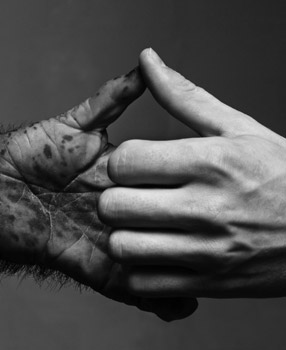FALL 2011 CONTENTS
Home
Game Change
On the verge of a revolution
Inside the labs
Highlighting recent Stanford cancer research
Cancer's biographer
A conversation with Siddhartha Mukherjee
The unexpected
Cancer during pregnancy
After cancer's cured
What's left to heal?
Make your own cancer diagnostic test
It's easier than you think

DOWNLOAD PRINTABLE
ISSUE (PDF)


In Brief
Canoodling with cavemen
Thanks for the genes
by Susan L. Young
Photo by Cary Wolinsky
For a few years now, scientists have known that humans and their evolutionary cousins had some casual flings, but now it appears that these liaisons led to a more meaningful relationship.
Sex with Neanderthals and another close relative — the recently discovered Denisovans — has endowed some human gene pools with beneficial versions of immune system genes.
Although modern humans, Neanderthals and Denisovans share a common ancestor in Africa, the groups split into separate, distinct populations approximately 400,000 years ago. The Neanderthal lineage migrated north and northwestward into West Asia and Europe, and the Denisovan lineage moved northeastward into East Asia. The ancestors of modern man stayed in Africa until 65,000 years or so ago, when they expanded into Eurasia and then encountered the other human-like groups.
Last year, a partial genome sequence of Neanderthals, who died out approximately 30,000 years ago, revealed the trysts left as much as 4 percent Neanderthal DNA in the genetic blueprint of some present-day humans. Last December, the genome of another human cousin, the extinct Denisovans, made clear that up to 6 percent of some people’s genomes are Denisovan in origin.
Now, a team of researchers led by Peter Parham, PhD, professor of structural biology and of microbiology and immunology, has found that these matings had a positive effect on modern human fitness. “The cross breeding wasn’t just a random event that happened; it gave something useful to the gene pool of the modern human,” says Parham, who is the senior author of the study, which was published Aug. 25 in Science Express.
The useful gift was the introduction of new variants of immune system genes called the HLA class-1 genes, which are critical for our body’s ability to recognize and destroy invading viruses and bacteria. HLA genes are some of the most variable and adaptable genes in our genome, in part because the rapid evolution of viruses demands flexibility on the part of our immune system.
“We are finding frequencies in Asia and Europe that are far greater than whole-genome estimates of archaic DNA in modern human genomes, which is 1 to 6 percent,” says Parham. Within one class of HLA gene, the researchers estimate that Europeans owe half of their variants to interbreeding with Neanderthals and Denisovans, Asians owe up to 80 percent and Papua New Guineans, up to 95 percent.

